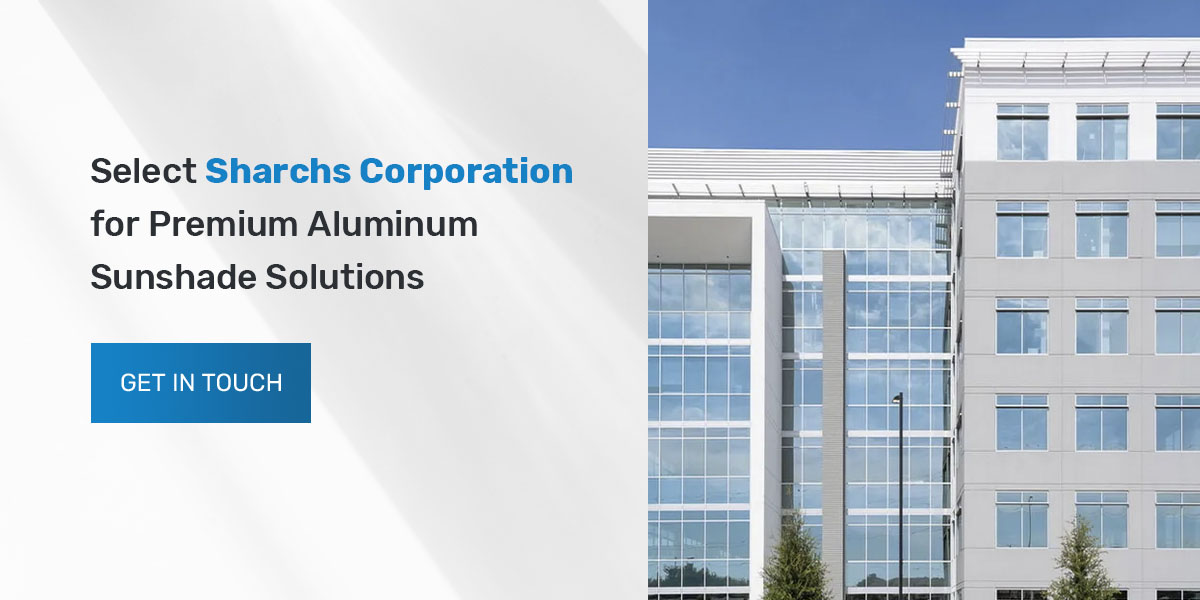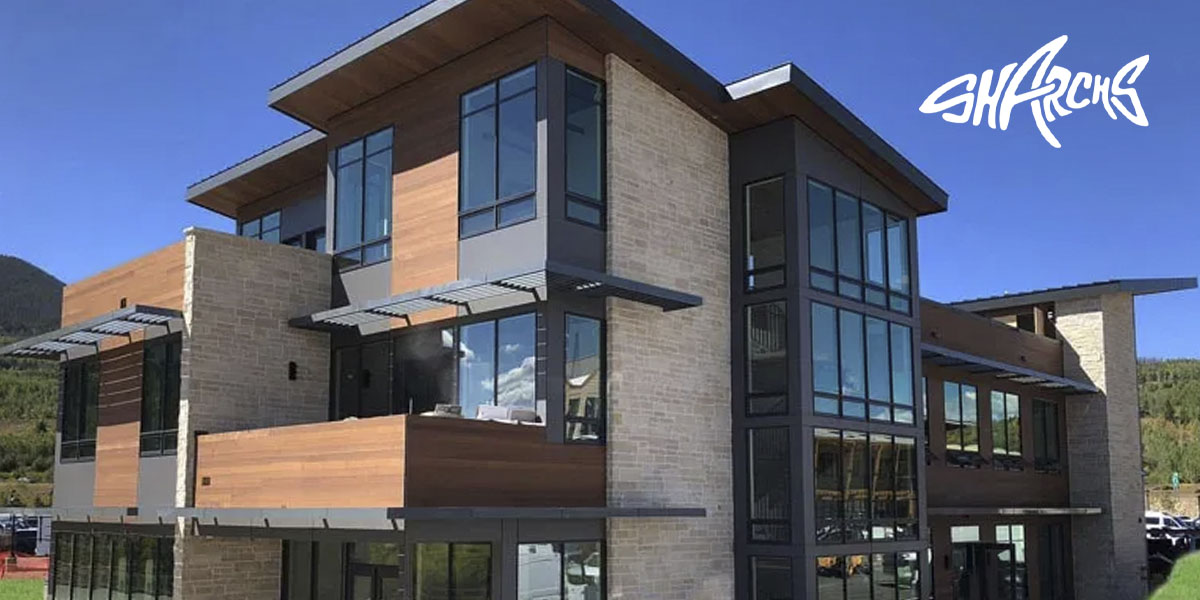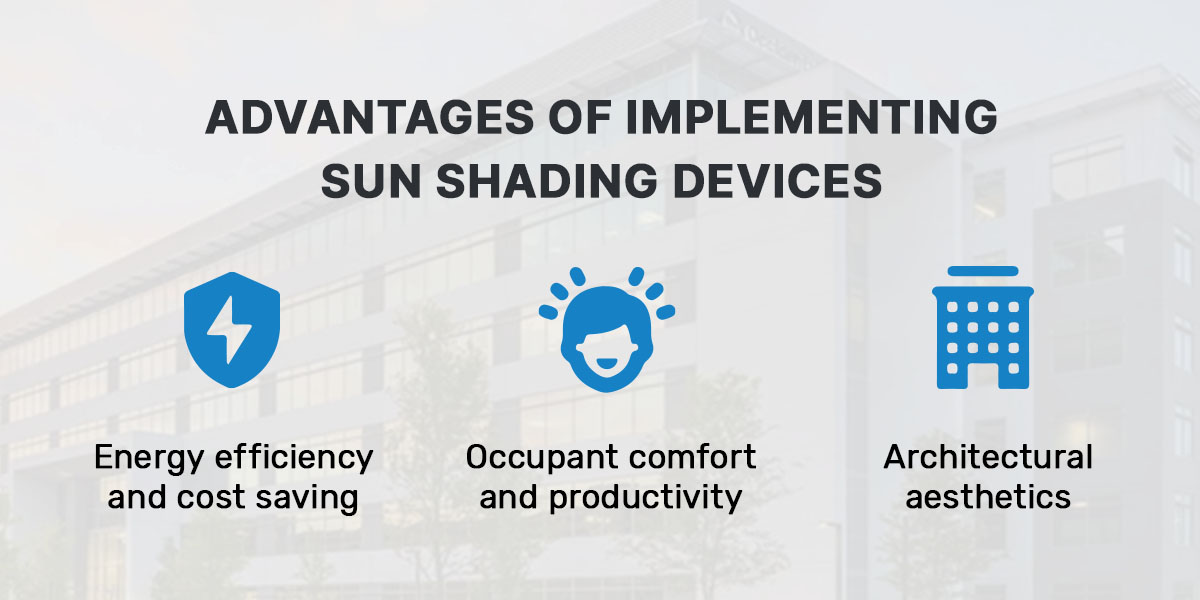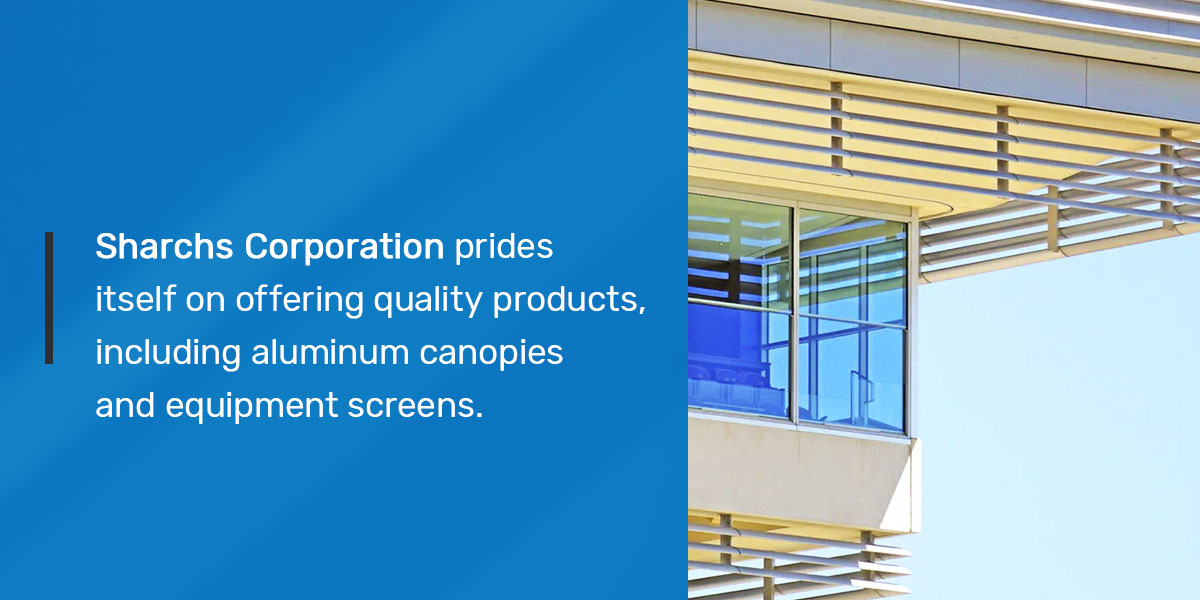When designing and constructing new buildings, architects, engineers, builders and other professionals must constantly weigh up specific considerations such as cost and design. Certain aspects often receive higher priority, but when it comes to sun control, using innovative designs can enhance building aesthetics, increase comfort and improve energy efficiency.
Modern buildings — and those receiving facelifts — should look to increase their energy efficiency. By reducing overall cooling requirements, architects can help save their clients money and reduce energy needs. Innovative designs offer cost-effective solutions that provide ease of installation and incorporate aesthetically pleasing elements that require minimal maintenance while offering passive cooling.
Delving into sun-shading architecture, we examine the fundamentals and break down the ins and outs of sun control. There are several different shading devices, benefits and strategies regarding implementation. As an architect, you can use effective sun shading to merge aesthetics and building efficiency to create spaces where sunlight access is crafted to enrich your overall vision.
Understanding the Basics of Sun Control in Architecture
You will likely consider several factors in your shading strategies that will differ based on the climate. For instance, in cold areas in the northern hemisphere, you want to maximize how much sun comes in from south-facing windows. In warm climates, you’ll hope to limit the heat and glare.
What Is Sun Control and Shading in Architecture?
Sun shading architecture is the intentional design and implementation of natural or human-made solar shading systems in buildings to control the amount of heat and sunlight that enters the building interiors people occupy.
Sun control helps architects manage sunlight penetration to regulate internal temperatures and minimize artificial cooling requirements. It involves incorporating different elements and devices to reduce glare and optimize light diffusion.
There are several practical applications and strategic reasons to incorporate sun shading products into your designs:
- Enhance energy efficiency: Help regulate temperatures passively to reduce energy consumption.
- Mitigate solar impact: Prevent excessive heat buildup and glare.
- Optimize natural light: Ensure spaces are well-lit — neither too harshly nor dimly.
The Science of Solar Control and Shading
One could examine complex scientific relationships between buildings and sunlight, but the fundamental aspects of solar control are simple. One key concept worth exploring is direct and indirect solar gain, which deals with heat absorbed from the sun, and it can significantly impact occupant comfort and a structure’s energy dynamics.
Excessive solar gain can lead to temperature imbalances, resulting in occupant discomfort and an increase in energy costs and consumption. Thankfully, simple architectural strategies such as proper orientation and effectively incorporating shading devices can help manage solar gain.
A shading analysis meticulously examines sunlight interaction with a potential or existing structure. It allows architects to predict and optimize a building’s solar exposure and the resulting effects.
Using this type of analysis, an architect can strategically plan their sun shading design to ensure they place shading devices to minimize unwanted solar heat while still maximizing natural light where needed.
Types of Sun Shading Devices
Architects have different devices at their disposal and can employ several strategies to manage sunlight penetration effectively. There are traditional and innovative solutions worth considering what to include in your sun shading design.
Two primary forms of sun shading include vertical and horizontal shading devices. Each of these is strategically positioned and installed on building facades to function as practical sunlight management tools without moving components and requiring no energy to function. The type you use will depend on the sort of window and which side of the building you are working on.
Additionally, maintenance is minimal once installed, and the devices last for years. When incorporated as a design component, these practical devices offer enhanced aesthetics while assisting with temperature regulation and more.
For vertical shading devices, some options include louvers or fins, and you can place these strategically on building exteriors to manage sunlight on east and west facades effectively.
Another means of regulating interior temperature is to use horizontal shading devices, including overhangs and awnings. These options are best suited to protecting against sunlight on south facades — in the northern hemisphere — to prevent excessive heat buildup and light.
The Benefits and Strategies of Sun Shading Design
Incorporating exterior sun control devices offers several benefits to the building and its occupants, including increased comfort and a durable shading solution. However, you must be strategic regarding how you implement them into your structural designs.
Advantages of Implementing Sun Shading Devices
By implementing different types of adequate sun shading devices, you can provide the following potential benefits:
- Energy efficiency and cost saving: By blocking the sun’s UV rays, you help minimize heat gain, reducing the need for energy-intensive cooling systems. This can ultimately lead to significant cost savings and help your design to align with sustainable practices.
- Occupant comfort and productivity: Strategically incorporating a combination of vertical and horizontal shading devices minimizes glare and lets you better regulate interior temperatures. This creates a comfortable environment and can increase productivity as the spaces will no longer be hot and stuffy.
- Architectural aesthetics: Sun shading architecture and working with the right sunshade manufacturer can ensure that these devices provide both a practical application and contribute to enhancing the structure’s visual appeal. Rather than creating an eyesore, you can incorporate these elements to add a layer of architectural sophistication instead.
Sun Shading Design Strategy and Analysis
When crafting a sun-shading design, you’ll need to conduct a thorough analysis, as you would with several other building components. You’ll then construct a design strategy.
When outlining effective sun shading design strategies, factor in the local climate, the building’s location and orientation, surrounding natural and human-made structures and expected solar exposure. This will let you strategize what sun-shading devices to use and how to use them effectively.
Consider using effective analysis methods such as computer-generated models and simulations to precisely display how effective your sun shading design is. In addition to ensuring its effectiveness, you’ll want to examine which products integrate seamlessly with your overall architectural design and style.
If you have a product that works practically but not aesthetically, speak with the manufacturer or supplier about customization options. This may also be necessary if your windows and other elements have non-conventional measurements.
Innovative Sun Control and Shading Solutions
As architecture changes and evolves, there are tried and tested methods that remain standard. At the same time, architects look to innovative solutions regarding issues such as sun control and shading.
Tailoring Aluminum Sunshades to Architectural Aesthetics
Aluminum sunshades offer immense design flexibility, and you can select between the benefits of either custom or prefabricated aluminum sunshades, meaning greater personalization and ease of incorporation.
There are countless cases of successful integration of aluminum sunshades with architectural design. In each case, architects could effectively leverage the adaptable nature of aluminum sunshades to integrate with their final design.
Aluminum is durable and effective at sun control. It is easy to manipulate and work with, so custom designs are less complicated to achieve than when working with other metals. Its lightweight nature also means that architects and engineers do not have to rely on steel structures for sun control.
Maximizing Comfort and Efficiency with Strategic Shading Design
There are several reasons to choose aluminum shades for business and other uses. It offers protection from the sun and reduces sun gain while allowing sufficient natural light to enter a space. For example, one could select to install interior smart blind systems. However, that will also mean blocking out light and lead to the need for artificial lighting.
There are several factors to consider, and you may even need to decide which systems could work in tandem with your aluminum sunshades. The goal is to achieve optimal balance. For instance, when weighing up performance and aesthetics and selecting architectural louvers, you can easily meet both of those needs. Louvers are visually appealing and regulate sunlight while optimizing energy efficiency.
Designing Effective Shading Systems
Designing effective shading systems means establishing an understanding of architectural and environmental factors to combine functionality with design excellence.
Key Considerations in Shading System Design
When creating shading system designs, you will want to consider several factors:
- Climate and location: There are several elements, such as temperature, humidity, wind patterns, beyond the sun. You must also consider the sun’s strength in that area and how long it shines. You’ll want to use materials and structures suited to that specific climate.
- Solar orientation: It is crucial to note where the sun will be throughout the entire day for each season in relation to the building.
- Building orientation and geometry: Look at how the building is positioned, shaped and laid out. You’ll need to look at the locations of doors, windows and even outdoor spaces.
- Daylighting and views: Consider the amount of natural light the building needs and the sort of view occupants want, as this will affect the type of system you use.
- Building materials: Considering the building materials, finishes and envelopes is crucial. For instance, how much glass is used and what are the finishes and general structural materials?
- Energy efficiency and sustainability: Shading systems can change how much energy a building uses if used effectively. Consider how to enhance the level of eco-friendly design with shading.
- Maintenance and operation: Select materials and sunshade devices that are easy to maintain and provide seamless operation.
Sharchs Corporation: Pioneers in Sun Control Solutions
Sharchs Corporation offers sun control innovation, commitment and excellence. We have been at the forefront of producing superior aluminum sunshades, aluminum canopies and other products since 2011. Our cooperation extends across various facets, from initial contact to offering advice, fabricating your final product and offering after-sales service.
Our Commitment to Quality and Innovation
Sharchs Corporation prides itself on offering quality products, including aluminum canopies and equipment screens. We also constantly ensure that we uphold high standards in our service, design, engineering, technical expertise and architectural integration. Our experienced and knowledgeable staff is ready to offer assistance in designing and engineering the ideal sunshade systems for your architectural vision.
We go beyond supplying aluminum sunshade products — we collaborate with you every step of the way if needed.
Our extensive aluminum sun control product options include several solutions, such as:
- Custom aluminum fabrication
- Sunshades for glazing
- Aluminum canopies
- Post-supported walkway covers
- Parking cover structures
- Cantilever aluminum canopies
- Bahama shutter sunshades
- Aluminum trellis systems
- Aluminum pergolas
- Aluminum equipment screens
- Aluminum architectural louvers
We emphasize American material sourcing and manufacturing to ensure we produce products that are a testament to our commitment to quality products and service. By incorporating these materials and manufacturing our products in America, we can better uphold our stringent quality control measures and ensure all products align with our standards.
Engineering and Architectural Expertise
At Sharchs, we offer premium products and services and include our knowledge and expertise by providing engineering and design services to assist with your sun control and shading projects. We are commercial manufacturers that bring diverse knowledge to each project.
We work with a range of professionals on their sun shade requirements, such as:
- Architects
- Metal fabricators
- Glaziers
- Awning companies
- Storefront installers
- General and subcontractors
Our competent design, engineering and architectural integration experts work with our sales teams to ensure you get the exact product you require for your project. From start to finish, the Sharch team is there to lend a hand and provide insightful advice as needed. Working with us, you’ll benefit from our years of knowledge and experience and the following:
- Exceptional customer service: Our communication is open, transparent, helpful and consistent. We follow through on our commitments to deliver what we promise.
- Tailored solutions: We have a range of standard options and offer custom aluminum fabrication. We can even deliver site-specific engineering services.
- Swift turnarounds: Many providers can make you wait up to 12 weeks, while our typical lead time is a rapid six to eight weeks.
- Cost-effective excellence: We provide manufacturing, service and product excellence at realistic prices. We consider your budget and advise accordingly.
Select Sharchs Corporation for Premium Aluminum Sunshade Solutions

If you would like to enquire about general information, ask product-specific questions or request a quote, please reach out to us to leverage our expertise and products on your next architectural project.
Contact us online, and we will get back to you as soon as possible.




